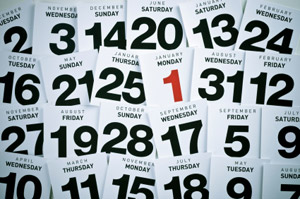This post is by Dr. Peter J. Meyers of 30GO30.
If you’re a plan junkie like me, New Year’s Day is your High Holy Holiday. There’s nothing quite as liberating as thinking ahead to an entire year of possibilities. Unfortunately, most of us hit January 1st running strong, only to be tripped up by the first obstacle in our path. I’d like to offer a few tips for keeping that New-Year feeling year-round.
Plan on the obstacles
I know it’s not sexy to plan for setbacks, but it’s essential. It’s easy to hit the gym during your time off, but if that exercise plan falls apart the day you have to go back to work, then what’s the point? You know you’re going back to work. You know that the holiday won’t last forever. Make sure your plans fit your real life.
Work out the details
If your goal is to “get in shape,” don’t just write it on a piece of paper and then watch all the Rocky movies back-to-back. Equip yourself with what you’ll need when January 1st comes. Do you need a gym membership? Do you need some equipment for home or a workout DVD? Are your running shorts in a condition that might get you arrested for indecency?
Figure it out in advance. If your planning is nothing but heady dreams of world domination, and you save the hard stuff for the new year, your plan will fall apart before it even begins. Don’t just make a resolution – resolve yourself to a specific, actionable plan.
Think day by day
It’s easy to make big plans and bask in the glory of what might be, but how do your big plans translate into day-by-day activities? What will you do, specifically, on February 17th or June 3rd? If your New Year’s resolution is to write a novel, you’re probably not going to just think really hard for 364 days and then spew out 400 pages on December 31st. How does that novel translate into pages and words on a daily basis? Are you going to write every day, or just five or six days each week?
If you ask these questions ahead of time and really know how your aspirations translate into action, you’ve got a great shot at succeeding. If you don’t, you may be writing a fairy tale.
Make planning a habit
Sometimes, we get carried away with New Year’s resolutions. The problem is, we’ve essentially picked only one day per year to plan the most important aspects of our lives. We plan every day for the minutiae of our lives, but somehow the really big, important goals get relegated to a December 31st motivational binge.
Set aside time every week to plan. Make it the same time, and really build a planning habit. Your big goals deserve that much. Of course, this means asking the tough questions every week, too. Is this the right direction? Do you have what you need to make it happen? If you set aside the time to evaluate and plan, you may change direction, but you’re much more likely to reach at least one of your destinations.
Dr. Peter J. Meyers (“Dr. Pete”) is a cognitive psychologist, accidental entrepreneur, and aspiring non-procrastinator. He recently founded 30GO30, a site dedicated to finding out exactly how much you can accomplish in 30 days.








Recent Comments